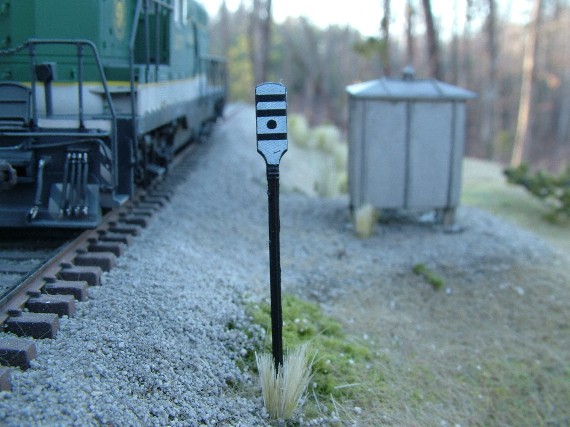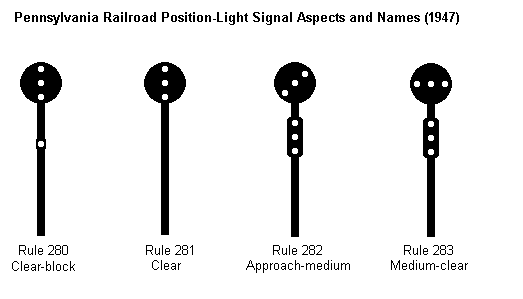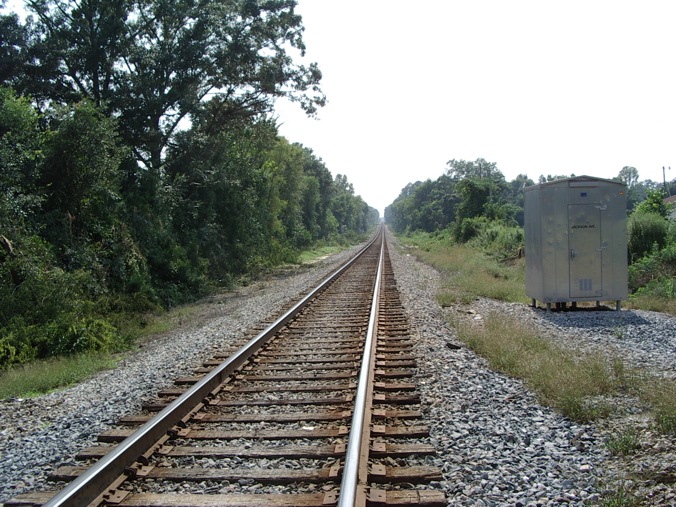This was originally posted in my blog on the Model Trains Universe site on April 27, 2007 and re-posted on the Piedmont Division Blog on November 16, 2007, and now re-posted here on the new MRH site today!
The last time I visited my local train shop I recall a conversation with Kim parker, he is the owner of Train Buddy Train Shop just off of Jenkins Road in Wake Forest, North Carolina Train Buddy (http://www.trainbuddy.com). We were mulling over the prototype operations of the Southern Railway and their use of whistle sign posts along the right of way, and then this led to a discussion of how this could be incorporated into model train operations on the layout. The discussion ended where we both agreed that there is a certain give and take when it comes to creating an accurate model of the prototype or applying real railroad operations to modeling operations.(see Image 1)i.

I wanted to research more about the prototype of the Southern Railway operations, so I went hunting. The more I found the more I wanted to find, so I became enthralled with the assignment. I want to share with you what I have learned about transforming a prototype real world railroad into a real world model railroad layout. While my personal research primarily focuses on the history of the Southern Railway, Norfolk Southern, and Norfolk and Western railroads, this article will touch on varied aspects of many others as well. I will also reference many sources, and primarily those from web sites that provide relevant information that supports research on the subject. In doing so, I will also utilize sources that are not always traditional in most model railroading or railroading related articles. For example, one of my resources is from a dynamic IT web site that happened to have a “Picture of the Day” posted an image of straight railroad tracks. In that vein and by the very nature, when a URL is available it will be provided in hypertext link format and the date it was accessed for this research will also be noted in the reference section. Web sites are changed, updated, or moved often, so the availability of these links cannot be guaranteed, however, they were valid at the dates specified in the reference.
Did I hear you say?
Walk into any train shop and the one word that is invariably guaranteed to pop up in most conversations is that ubiquitous declaration - prototype. This utterance can be found in simple yet heartily phrased statements such as (in a deep vocal tone) “…and when modeling the prototype you must consider…”, or “Prototype operations are the foundation of solid modeling…”, or “The prototype is your starting point for creating an accurate model of…”, and so on.

Early on in my modeling goings-on I had a fear of the prototype, and I think most beginning modelers feel the same way, I reached a point where too much information became more than I could handle. For some modelers this fear becomes a stumbling block for further progression in the hobby, and for others they just throw up their hands in disgust and give up trying. Some modelers resolve within themselves to find a happy medium and do not get too concerned or caught up with modeling the prototype in form, function, or operations. I mean what the heck does Rule 281 mean and why do I need to know that? I can stop and start my model trains anytime I dam well please right! Okay, for those who don’t know, Rule 218 as specified by the Pennsylvania Railroad in 1947 is stated in the following text: Clear: Proceed. The signal is displayed at the entrance of an interlocking or automatic block, or by a distant signal protecting an isolated facing-point switch. (See Figure 1.)ii.
I reached a point where I overcame the initial fear and began studying more about what the real world railroad does, I started asking questions like how does the railroad get their work done, and how do these trains go from point A to point B? Like me, many modelers continue to persevere and set in motion a long climb to conquer the summit known as the prototype. We study it, we learn about it, we research it, we dig up information about it, we travel long distances to find locations with current activity (AKA rail fanning), and we take many pictures along the way. And then somewhere along the way in the recesses of our mind it all starts to click and make sense. The once felt fear of the unknown turns into a fever, and I am not talking about a sickness, but a passion, a passion to discover more about this ever elusive archetype known as the prototype. So what is this mysterious prototype and where did it come from?
What is a prototype?
Let’s start with the text book definition of the word as found from Merriam-Webster OnLine Dictionary:iii.
prototype
Main Entry: pro-to-type
Pronunciation: ‘prO-t&-”tIp
Function: noun
Etymology: French, from Greek prOtotypon, from neuter of prOtotypos archetypal, from prOt- + typos type
1: an original model on which something is patterned: ARCHETYPE
2: an individual that exhibits the essential features of a later type
3: a standard or typical example
4: a first full-scale and usually functional form of a new type or design of a construction (as an airplane)
So, from the official definition a prototype is the original standard and typical example that exhibits the essential features that make up the full-scale 1:1 functional object. According to Ron Hildebrand of the Proto 87 Chroniclesiv. web site:
"Prototype modeling attempts to get as close to prototype realism and accuracy as possible. It really isn’t strictly defined–there are no “standards” that define how much one can deviate from the prototype and still be considered a prototype modeler–so let’s call it a “state of mind”. Obvious no-nos would be to put C&O Progress decals on single-sheathed box car: since such a car never existed in real life, as a prototype modeler, you wouldn’t do it. Neither would one run a Southern Railway steam locomotive with a string of Southern Pacific passenger cars. And you don’t letter any steam locomotive for Amtrak! It’s usually a lot more subtle than those examples however, having to do with “rivet counting” and all that. You get the idea, I’m sure. Prototype modeling usually applies mostly to locomotives and rolling stock, although it can easily be expanded to include everything about a layout."
Ron really makes sense to me in his statement that it is more of a state of mind than it is a standard defining a specific prototype to modeling direct method. His example of a modeler putting certain decals on a certain box car are visually fitting and are a good anchor for narrowing the scope on what it means to model in a prototypical fashion. He also touches on a “hot” topic that I will mention later.

Where can I find the prototype?
Just look in your back yard! Well, maybe not “your” back yard, but I bet if you drive around the streets in your neck of the woods for 30 minutes or so you will eventually come across a railroad track. I see examples of the prototype everyday and wonder how these can be modeled in an accurate representation, only in a smaller space. I will be driving to or from work and start noticing things along the way, like a rock cut, or a grassy field, or the way a certain tree has fallen into the edge of Falls Lake, or the Norfolk Southern railroad bridge over T.W. Alexander Road. And then I start to wonder how I would model that scene, tree, structure, bridge, or grassy field on my layout. I find myself always thinking of how an aspect of the real world can be applied to the model railroad layout.
Since I model HO which has a ratio of 1:87.1 to the prototype, factors must be taken into account when space limitations are considered. For example, it would be totally impossible for me to model the nation’s longest straight stretch of track, the CSX line between Laurel Hill and Acme in North Carolina, where the grade does not stray of course for 78 miles.v.

Stand at the grade crossing along the route in the small town of Maxton, NC and the headlight of the oncoming train is visible for several minutes before it comes near (See image 2)vi.. Out of just pure speculation and modeling interest, let’s say I wanted to accurately model a full 78 mile stretch of straight track on an HO scale layout, how could I make that happen? Modeling this 78 miles stretch in HO would take approximately 4,728 feet, or just over 1,576 yards. To house this straight stretch of HO track in detailed and completely accurate prototype fashion would take a building that would be at least 16 football fields lined up end to end. Heck, a mile is 5,280 feet, so this building would have to be almost a mile long. I feel for the person who has to sweep that floor. And think of how much maintenance those modeled tracks would be, not to mention the cost factor. Just for fun, I worked up figures for the straight track portion of the modeled 78 mile stretch on the layout and depicted accurately in HO would cost about $4,570.75 + tax at today’s prices, and this is for 3 foot sections of Atlas code 83 flex track. Not exactly what I had in mind when modeling the prototype. I am only trying to make a point here, and that is when modeling the prototype you have to know where you can fudge a little and where you want to approximate the prototype.
How do you model a prototype accurately?
There is no one-way to model a prototype and the variations are many. However, there are some techniques that have been identified and are in common use today that assist the modeler in representing an accurate model of the prototype. As stated earlier, it would be impossible and unrealistic to model a 78 mile stretch of straight track in any model train scale. So how do you go about approaching an accurate representation of a prototype railroad?
Compression, isn’t that how diamonds are made?
Let’s review one of the popular modeling techniques utilized today, selective compression. I hear this phrase a lot these days, especially in the online forums, magazines, books, and the Internet all have references to it, and so what’s the big deal with selective compression?. What am I selecting and compressing it into what? Is it like a trash compactor, putting more stuff into a tightly bound bag and hoping for the best? Or when you compress this stuff, does it turn into something else? Like carbon pressed into a diamond! Sort of! I ask a lot of questions, I know, so let’s pry a few rocks back to find the answers together. Get out your rock hammers and your picks, and let’s start some real digging!
Part II will focus on selective compression, layout design elements, and making the best with an imperfect situation.